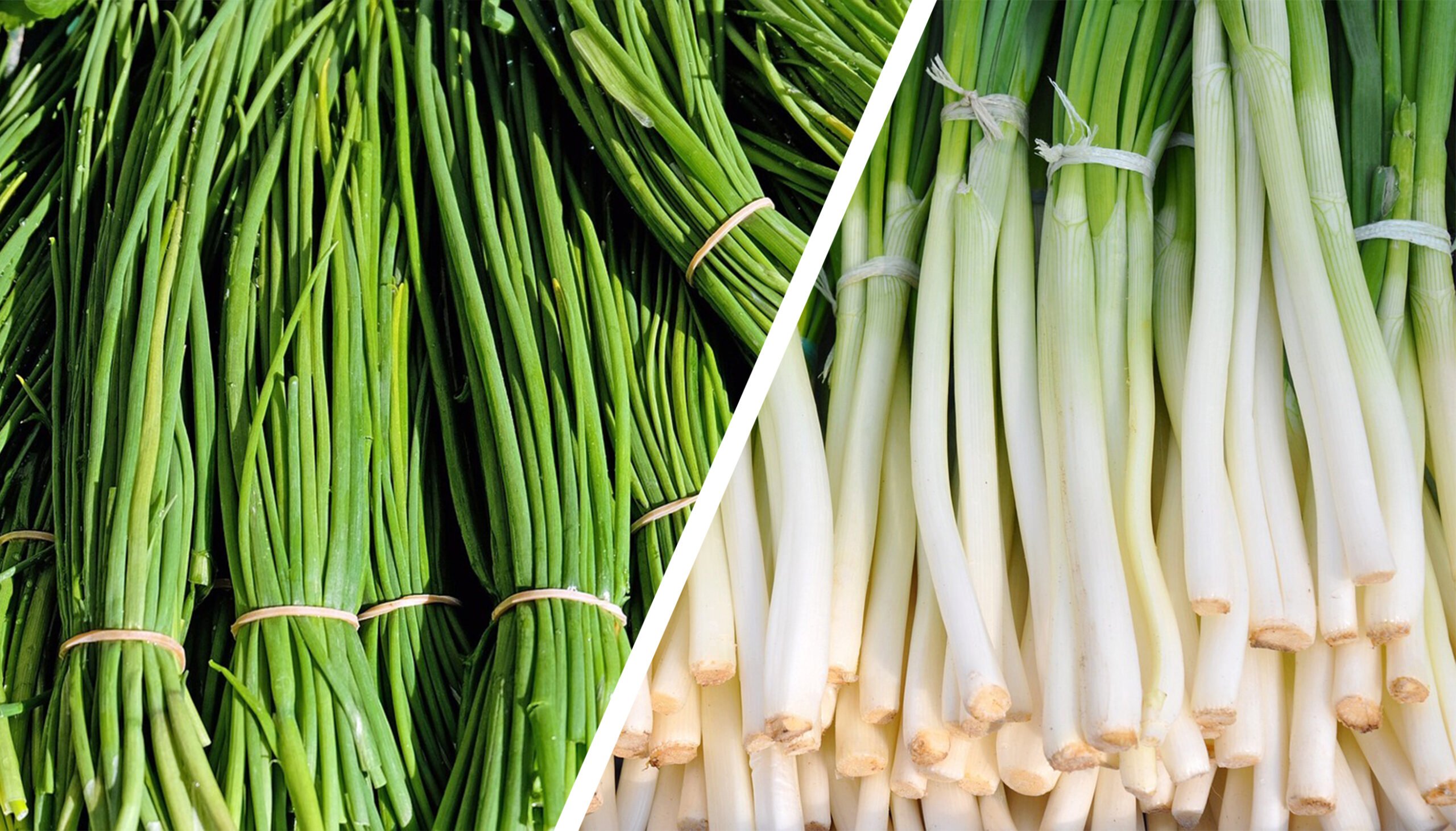Green onions and chives are two popular ingredients in the world of cooking, known for their mild, onion-like flavor and vibrant green appearance. These versatile herbs can add depth and flavor to a wide range of dishes.
While they may seem similar at first glance, green onions and chives have distinct differences in terms of taste, appearance, and culinary uses.
In this article, we’ll explore the characteristics of green onions and chives, helping you understand when and how to use each one in your cooking.
Green Onions (Scallions)
Green onions, also known as scallions, belong to the Allium fistulosum species. Unlike chives, green onions have a more robust and pronounced onion flavor.
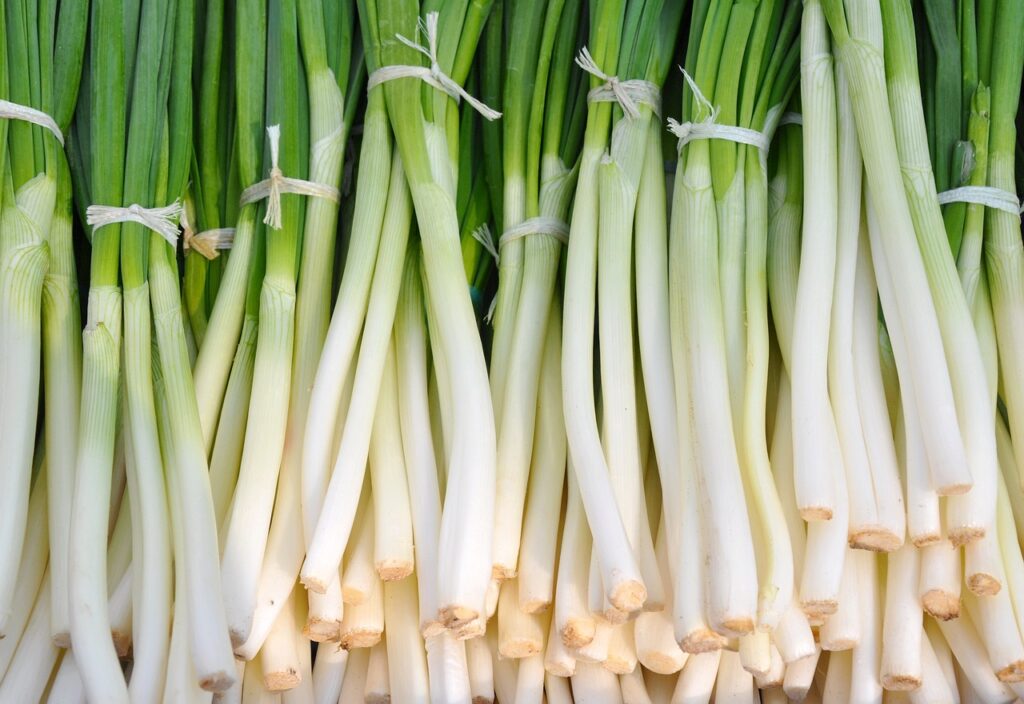
Here are the key characteristics of green onions:
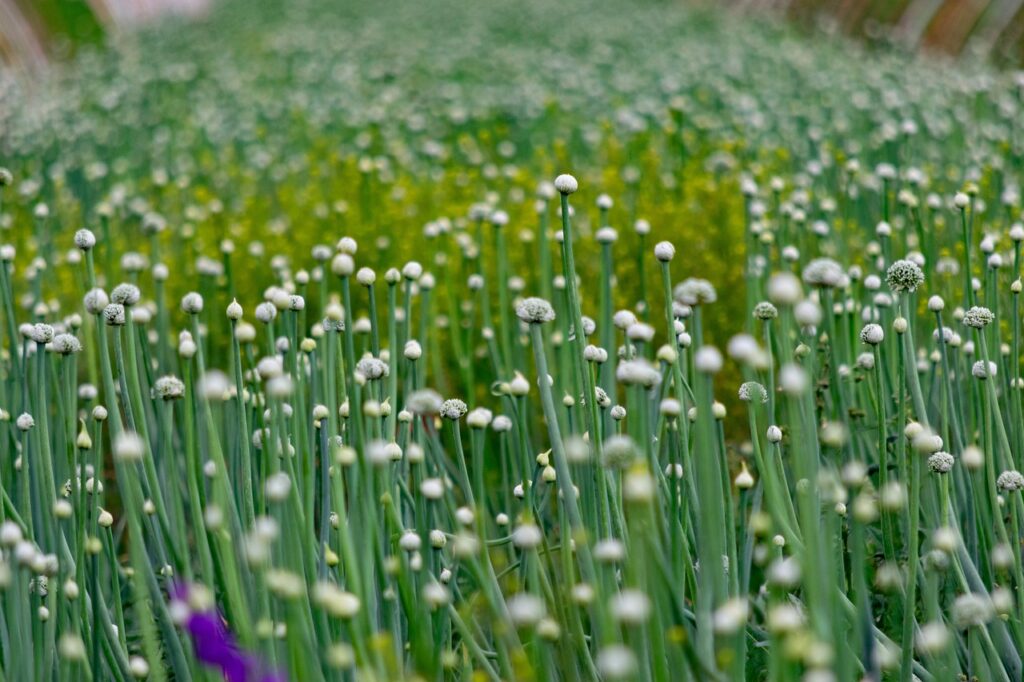
- Appearance – Green onions consist of both a white, bulbous root and long, slender green leaves. The white part has a stronger flavor, while the green tops are milder.
- Flowers – Flowers are small, spherical, and non-edible flowers that emerge in late spring to early summer. These flowers are typically white or pale green and have a less ornamental appearance compared to chive flowers.
- Flavor – Green onions have a more intense and classic onion flavor, with a peppery bite. The white part is sharper, while the green tops are milder.
- Culinary Uses – Green onions are incredibly versatile and can be used in various dishes. They are commonly used in stir-fries, salads, as a garnish for soups, and in salsas. They can also be grilled or used in marinades for meats.
- Freshness – Green onions can be used in both cooked and raw dishes. The green tops are often used raw as a garnish, while the white part can be sautéed, grilled, or stir-fried.
- Nutritional Benefits:
- Low in calories and a source of dietary fiber for digestive health.
- High in vitamin K, important for bone health and blood clotting.
- Provides a significant dose of vitamin C, bolstering the immune system and skin health.
- Contains potassium, which helps regulate blood pressure.
- Contains a small amount of iron and offers antioxidants that protect the body from free radical damage, promoting overall health.
Chives
Chives, scientifically known as Allium schoenoprasum, are slender, delicate herbs that belong to the Allium family, which includes garlic, onions, and leeks.
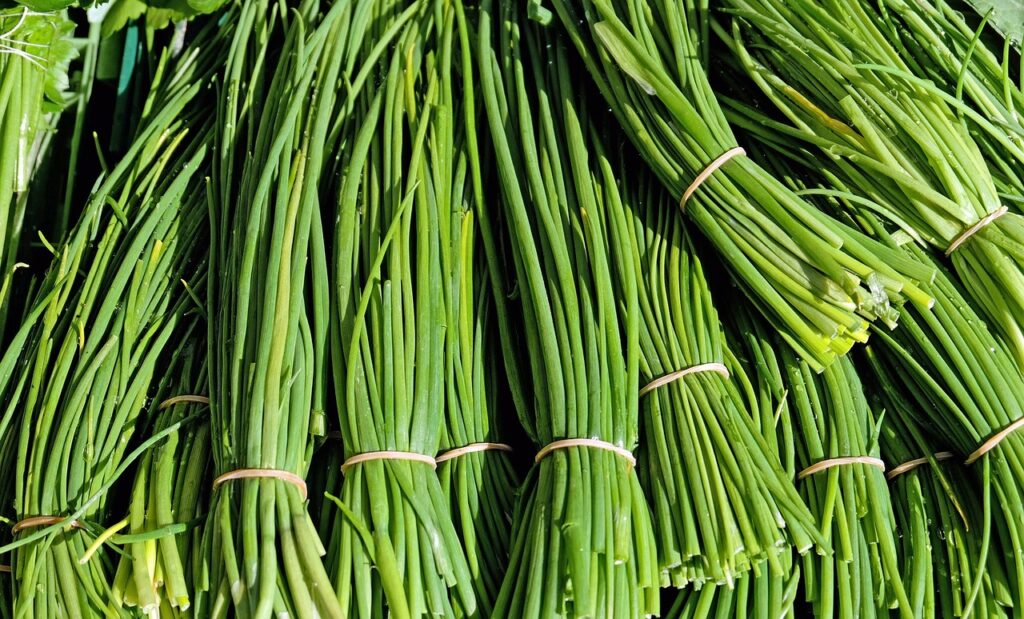
They are known for their mild, slightly onion-like flavor with a hint of garlic, and they have a hollow, tube-like structure. Here are some key features of chives:
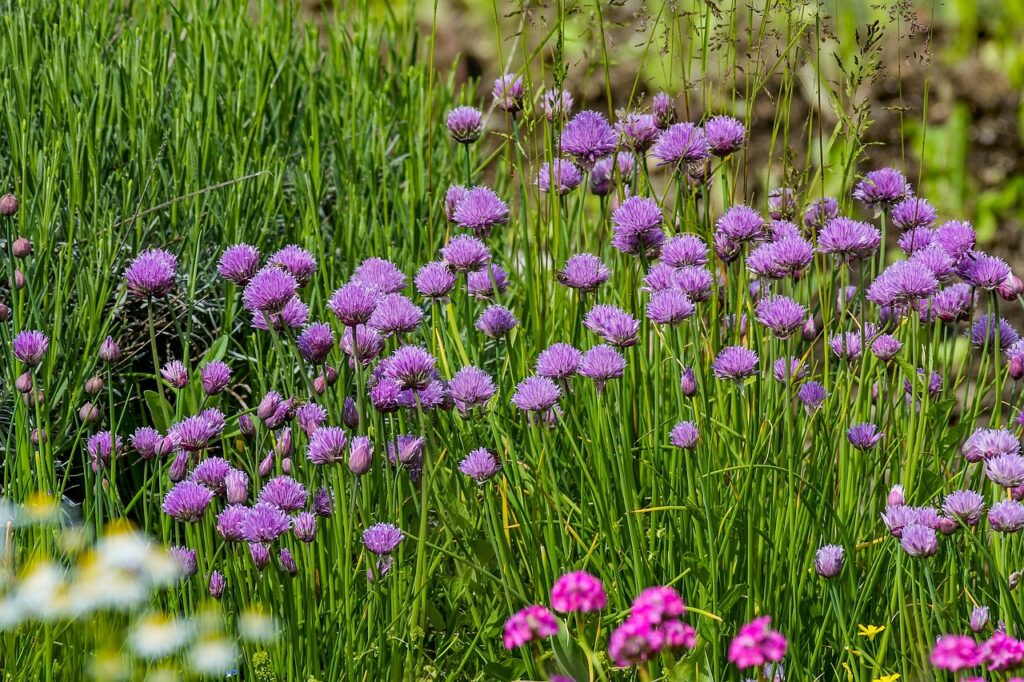
- Appearance – Chives are characterized by their thin, tubular leaves that are bright green in color. The leaves can grow to be around 12-20 inches in length.
- Flowers – Small, delicate, and edible flowers that appear in late spring to early summer. These star-shaped flowers are typically violet or purple in color, adding a beautiful visual element to the herb garden. The flowers are often used as a garnish in salads, soups, and various dishes, lending a mild onion flavor with a hint of garlic.
- Flavor – Chives have a delicate and mild flavor, making them an excellent addition to dishes when you want a subtle hint of onion and garlic without overwhelming the other flavors.
- Culinary Uses – Chives are often used as a garnish in salads, soups, and omelets. They also work well in cream-based sauces, dips, and as a topping for baked potatoes.
- Freshness – Chives are best when used fresh, as their delicate flavor can diminish when cooked. They are typically added to dishes towards the end of the cooking process.
- Nutritional Benefits:
- Low in calories, making them a diet-friendly option.
- Rich in vitamin K, crucial for bone health and blood clotting.
- Good source of vitamin C, supporting the immune system and skin health.
- Contains small amounts of essential minerals like calcium and iron.
- Offers antioxidants that protect cells from oxidative stress and inflammation.
Choosing Between Green Onions And Chives
When it comes to choosing between green onions and chives for your recipes, consider the following factors:
Flavor Intensity
Chives are the milder option, providing a subtle onion and garlic flavor.
If you want a more pronounced onion taste, go for green onions.
Appearance
Chives are recognized by their slender, hollow leaves, while green onions have white bulbs and long green tops.
The choice may also depend on the visual appeal you want to add to your dish.
Culinary Application
Think about the specific recipe you’re preparing. Chives are excellent for delicate dishes where a mild onion and garlic flavor is desired, while green onions work well in heartier, savory recipes that can benefit from a stronger onion taste.
Cultivation
Both green onions and chives can be successfully cultivated by home gardeners, and the choice between them may depend on your preference for a perennial herb (chives) or a more frequently replanted annual or biennial crop (green onions).

Additionally, the specific growing conditions, such as soil pH and sunlight, can influence which herb is better suited to your garden.
Cultivating Green Onions
- Green onions, or scallions, are also relatively easy to cultivate and can be grown in outdoor gardens or containers.
- They thrive in well-draining, loose soil with a pH ranging from slightly acidic to slightly alkaline.
- Green onions can be grown from seeds, sets (small bulbs), or by regrowing the white bulb base from store-bought scallions.
- They require full to partial sunlight and should be watered regularly, ensuring the soil stays consistently moist but not waterlogged.
- Green onions are usually grown as an annual or biennial crop, which means they complete their life cycle within one or two years.
Cultivating Chives
- Chives are easy to grow and can be cultivated in a variety of settings, such as outdoor gardens, containers, or even indoors.
- They thrive in well-draining, fertile soil with a slightly acidic to neutral pH.
- Chive seeds can be sown directly into the garden or started indoors and transplanted when they reach a suitable size.
- They prefer full to partial sunlight and should be watered consistently, keeping the soil evenly moist.
- Chives are perennial herbs, and once established, they will return year after year, making them a low-maintenance option for home gardeners.
Cultivation Comparison: Green Onions vs Chives
- Both green onions and chives are relatively low-maintenance plants, making them suitable for beginner gardeners.
- Chives are perennial, while green onions are typically grown as annual or biennial crops, which means you may need to replant green onions more frequently.
- Chives can thrive in a wider range of soil pH levels, while green onions prefer soil that is slightly acidic to slightly alkaline.
- Chives are primarily grown from seeds, whereas green onions can be grown from seeds, sets, or even by regrowing the white bulb base from store-bought scallions.
- Both herbs benefit from consistent watering to keep the soil moist, but overwatering should be avoided to prevent root rot.
- Chives can be an attractive addition to herb gardens or ornamental beds with their slender, upright growth, while green onions have a more traditional vegetable garden appearance.
FAQs (Frequently Asked Questions)
These frequently asked questions should provide you with a better understanding of the differences between chives and green onions, their culinary applications, and their nutritional benefits.
Whether you’re a seasoned cook or just starting out in the kitchen, these insights can help you make the most of these flavorful herbs in your dishes.
1. Are green onions and chives the same thing?
No, green onions and chives are not the same. While they share a similar appearance and mild onion-like flavor, they have distinct characteristics. Chives have slender, hollow leaves and a delicate flavor, whereas green onions have a white bulb and long green tops, offering a bolder onion taste.
2. Can I substitute chives for green onions, and vice versa?
Yes, you can substitute chives for green onions in dishes where a milder onion and garlic flavor is desired. However, the reverse is not always true, as green onions have a stronger flavor that may overpower the dish if used as a chive substitute.
3. How should I store chives and green onions for maximum freshness?
To keep chives fresh, store them in the refrigerator, wrap them in a damp paper towel, and place them in a plastic bag. Green onions can be stored in the refrigerator with their roots intact in a glass of water or in a plastic bag with a paper towel to absorb excess moisture.
4. Are there any health benefits associated with green onions and chives?
Both green onions and chives offer health benefits. They are low in calories and provide essential vitamins like vitamin K and vitamin C. Chives and green onions also contain minerals, antioxidants, and dietary fiber, contributing to overall well-being.
5. Can green onions and chives be used in cooked dishes, or are they best served fresh?
Chives are best used fresh or added towards the end of cooking to preserve their delicate flavor. Green onions can be used in both cooked and raw dishes, with the green tops often used raw as a garnish and the white part suitable for sautéing, grilling, or stir-frying.
6. Are green onions and chives safe for individuals with onion allergies?
Green onions and chives are members of the Allium family, which includes onions, garlic, and leeks. While they have a milder flavor, individuals with severe onion allergies should exercise caution and consult with a healthcare professional if they are uncertain about their tolerance to these herbs.
Conclusion
Green onions and chives, despite their similar appearance, offer different flavor profiles and are suited to various culinary applications.
Understanding the distinctions between these herbs can help you enhance the flavors of your dishes.
Whether you opt for chives’ delicate subtlety or the bolder presence of green onions, both can elevate your cooking and add a touch of freshness and vibrancy to your meals. The choice ultimately depends on your culinary preferences and the specific dish you’re preparing.
Also Read: 10 Most Common Crops in the Philippines: A Comprehensive Overview
Well, what do you think about the article?
Did you enjoy reading “Green Onions Vs Chives: A Culinary Comparison“? We really hope that you have enjoyed this article. If you have any thoughts or comments about this post, please feel free to share them in the comment section below. We appreciate your feedback and would be glad to hear from you.
To see more content like this check the gardening section of Money For My Beer.

Lara is a freelance content writer and a cat mom to three furbabies, Mizu, Haru and Sora.
She graduated with a Bachelor’s Degree in Architecture and is a registered and licensed Architect. Aside from writing, she is fond of growing cacti and succulents and is a DIY type of girl.
During her free time, she engages herself in water-colouring and crocheting, while catching-up with an old tv series she just discovered. Lara loves to explore new places, but most of the time stays in her hometown province, reading historical romance novels over a cup of coffee – or matcha.

